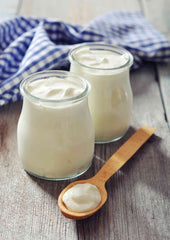What flavors go well with matcha? In this article we are going to try and find out!
We’ll first start by examining what flavors go well with matcha and then we’ll talk about a few foods that have these flavors that you can use to pair with your ceremonial matcha.
Let’s get pairing!
So What flavors go well with matcha?
We made a special YouTube video to explain flavors that go with matcha. Tell us what you think about it in the comment section of this article!
Flavors that go with Matcha:
1. Sweet
If you’re wondering what flavors go well with matcha, you generally can’t go wrong with sweet things. Matcha flavors have actually been paired with sweets or “wagashi” for hundreds of years. Originally, these sweets were made out of simple ingredients like fruit and nuts but once the Europeans introduced sugar into Japan in the 1600’s, it made it possible to create many different creations, some of which are works of art. To create wagashi, a combination of beans, sugar and starch like arrowroot powder are used. These 3 simple ingredients, along with food colorings are used to create the vast assortment of wagashi we see today
2. Smooth/ creamy
One of the complaints people have with matcha flavors is that it has a little bit of bitterness to it. Instead of adding sugar to matcha (which you should never do) instead what you can try is pairing it with something to reduce the bitterness. It's usually a good idea to pair matcha with foods that have a smooth or creamy flavor to them like white chocolate or ice cream. This is also why a matcha latte works so well. Once you know what flavors go well with matcha, it will be easy to create your own food pairings and matcha lattes at home.
The Taste of Matcha Tea
Before we take a look at what flavors go well with matcha, let’s talk a little bit about the taste of the matcha itself. Matcha flavors are known for having this really strong grassy or vegetal flavor. It also has a subtle, naturally sweetness and a creamy or milky consistency.
Finally, the taste profile that makes matcha most unique is this savory or “umami” flavor. This savory or brothy flavor is something you would normally associate with a meal like soup, and not in a drink like tea, but it is celebrated when it comes to matcha tea.
This unique combination of flavors makes it difficult to pair matcha tea with certain foods, so it is really important to follow this guide so you know what flavors go well with matcha.
Top food pairings for Matcha
Matcha, a powdered green tea, pairs well with various flavors and ingredients.
Mochi, a soft and stretchy rice dough, and wagashi, traditional Japanese sweets, are both great companions to matcha due to their subtle sweetness and ability to cleanse the palate.
Neutral flavors like frozen yogurt, white chocolate, wafers, and oat milk provide a smooth and sweet contrast to matcha's bitterness.
While citrus fruits like orange, lemon, and lime intensify the matcha flavor, black sesame seeds add a mellow earthiness to enhance the vibrant matcha taste.
Lastly, bananas offer a simple yet delightful pairing with matcha, as their neutral sweetness complements the tea without overwhelming its flavor.
1. Mochi

It’s hard to talk about what flavors go well with matcha and not talk about mochi, it’s like these two were made for eachother. Mochi is a type of rice dough that is made by pounding glutinous rice until it becomes soft and stretchy. The rice dough can then be wrapped around other ingredients like anko (sweet azuki bean paste) to make daifuku. The daifuku is then often topped with a type of flour, kinako (roasted soybean flour) or sesame seeds are popular.
This can be a great treat to enjoy alongside a bowl of green tea, particularly matcha. It may be tempting to think of wagashi as a “dessert” but it is really more like a palate cleanser. If you are used to western-style desserts, the sweetness of this may be pretty subtle. If you eat this alongside your matcha, it can really help to smooth out a lot of the bitterness without directly impacted the taste of the matcha flavors.
2. Wagashi

If you are wondering what goes well with matcha, you can't go wrong with wagashi Other types of wagashi are made with similar ingredients. The most decorative ones are usually reserved for special occasions like tea ceremonies but there are much more simple forms of wagashi like Doryaki and Dango.
Just as with the mochi, these desserts are designed to have just enough sweetness to cleanse the palate, but they are nowhere near as sweet as something like a cupcake for example.
This makes them the perfect airing for a bowl of matcha, they can cut through the bitterness without stealing the show. In general, if you're looking for flavors that go with matcha, you want to go with things like this that are sweet, but not too intense in their flavor profile, as this will clash with the matcha flavors.
3. Fozen yogurt

Frozen yogurt is another example of a sweet and neutral flavor. With this one, the flavor of the frozen yogurt matters, so make sure you go for something like vanilla, as this will clash the least with the flavor of the matcha.
One thing you can try is actually make a matcha paste and drizzle it on top of the frozen yogurt or mix it into the frozen yogurt.
This is an easy way to make a matcha frozen yogurt and you can do the same thing with vanilla ice cream.
4. Cocoa powder

If you are searching for what goes well with matcha, cocoa powder may be one of the last matcha pairings on your list. Cocoa powder works pretty well with matcha, but just make sure you don’t overdo it. Both chocolate and matcha have very intense flavor profiles and they are very different.
Matcha leans into more of these grassy or steamed vegetable notes and chocolate is on these warmer or darker flavor profiles. These two flavors are at opposites with one another, and they don’t mix so well together.
You can however get away with a tiny but of cocoa powder sprinkled on top of your matcha and you will find that it may add to the richness. As long as you are subtle with it, these can be great flavours that go with matcha. Try it out and let us know what you think!
5. White chocolate and wafers

On the list of what flavours go well with matcha, white chocolate has to be at the top of the list.
White chocolate is made without the cocoa, so instead of having this rich chocolaty flavor, it is more buttery and neutral.
This is the best type of food to pair with matcha, smooth and sweet enough to help you with some of the bitterness but not too flavorful that it clashes with the matcha. If you like the type of white chocolate that comes with wafers inside, this can also work well.
6. Orange, Lemon and lime

As we mentioned before, these citrusy flavors seem to clash with the matcha, but if you are a fan of citrus fruit, you should definitely go ahead and try this pairing.
You will notice that the taste of the matcha becomes more powerful and the finish becomes stronger. If this is too intense for you, we would instead recommend going for the other food pairings on this list.
Oranges and lemons, say the bells of St. Clement's!
7. Black Sesame

Sesame is a flowering plant in the genus Sesamum, also called benne. Numerous wild relatives occur in Africa and a smaller number in India.
Black sesame seeds are often used on top of daifuku, and these can pair great with matcha.
The mellow earthy flavors and subtle sweetness of black sesame is a good complement to the more vibrant flavors of the matcha. Black sesame seems to work well with just about anything and matcha is no exception!
8. Oat Milk

Of course the list of what flavors go well with matcha would not be compete without talking about oatmilk. This is a classic example of the “neutral sweet” flavor mentioned earlier.
This is why oatmilk is becoming so popular in matcha lattes. It is sweeter than dairy milk and it doesn’t have the lingering aftertaste. Oatmilk is not really a “pairing” but more of an ingredient you can use with matcha to enhance the flavors of each.
If you are currently making matcha lattes, try one with oatmilk and see what you think!
9. Banana

Back when we were doing a list of what flavors go well with matcha on instagram, the banana actually one. All we did for this comparison is make up a tiny bit of koicha paste and dip a banana inside.
The flavors worked great together and it really tasted like a dessert, as if you had dipped the banana in chocolate or something. It is amazing how something so simple can be the best pairing, but it is again an example of this “neutral sweet” phenomenon.
The banana is sweet enough to smooth out the matcha but it doesn’t have a ton of flavor to it so the flavors don’t clash. If you're looking for what fruit goes with matcha, the banana can't be beat.
What fruit goes with matcha other than bananas?
So besides the bananas we mentioned earlier, what fruit goes with matcha? Strawberries work very well because even though they have a bit of a citrusy taste to them, they also provide a lot of sweetness. Mangos offer the same type of matcha pairings and they can work beautifully.
The fruits you will want to avoid are things like green apple or anything that is tart without being sweet. This will really amplify the dryness and bitterness of the matcha.
What flavor goes well with matcha latte?
In your search of flavors that go with matcha, you may also be interested in what flavor goes well with matcha latte. Because there is milk and sugar included in a matcha latte, the strong matcha flavors have already been smoothed out, so you can be a bit more adventurous.
Still, when it comes to what goes well with matcha latte, you will want to follow the "neutral, sweet" guidelines and eat things like white chocolate, mochi and wagashi. You can try a lighter milk chocolate and see how you like it. While these are normally not flavors that go with matcha, the
So when it comes to what flavors pair well with matcha latte, feel free to experiment a bit more as you won't get the same "clashing" effect that you get when you drink plain matcha.
What flavors are bad with matcha?
In addition to covering what flavors pair well with matcha, we also want to cover a few that do not work particularly well. These foods either clash with the intense matcha flavors, or they aren't able to properly smooth out the bitterness. Here are a few to avoid.
Citrus flavors
Citrus flavors are actually not good to pair with matcha. When you mix lemon juice with matcha for example, it can really enhance the more astringent components of the tea. This may be a good thing if you appreciate these citrusy flavors in the matcha, but most people do not. If you really want to combine the two flavors, you can use something like a lemonade that combines both the citrusy and the sweet flavors and balances out the spike in astringency.
Unsweet treats
In a very unscientific study, we tested matcha out with both a regular croissant and a sweet croissant and found that the sweet croissant worked much better. It seems that when it comes to food pairings, matcha just needs a little bit of sweetness to get off the ground. If you eat something too sweet, it may steal the show from the matcha tea, but a little bit is nice to counter some of the natural bitterness. We haven’t gotten good results from things like bread or crackers as a food pairing, because they don’t provide any sweetness or any creaminess to counter the bitterness.
Rich, flavorful foods
Matcha has a really intense flavor so when it comes to food pairings, it’s generally not a good idea to introduce anymore. You will find flavorful things like rich chocolate cakes or fruit pies don’t work as well as you might think. This is because the flavors of the two treats are really battling it out and your taste buds don’t know what to make of it.
How to sweeten matcha correctly
When you sweeten matcha directly, you really make it hard to pick out the subtle flavor profiles of the tea. What we recommend if you have to “sweeten” the matcha is to do it indirectly by enjoying a flavor pairing. This will allow you to continue to expand your palate, while still cutting out some of the bitterness you might notice. By using sweeteners indirectly rather than directly, you are able to enjoy the flavors of both treats without distorting them.
Final words on flavors that go well with matcha
Of course even with all these flavor pairings, the best way to enjoy matcha is still on its own, without milk or sugar. When you do this, you are able to experience the full, natural spectrum of flavors just as the producer intended. This brings a closer connection between the tea drinker, and the field the tea was produced on.
High quality matcha tea should have a natural sweet and smooth flavor to it which is developed through a long and careful production process. After traveling around Japan for the past few years, we have met with dozens of farmers and sampled hundreds of different teas. We selected 21 of our favorites to share with you in our matcha sampler. With this matcha sampler, you can try 21 different types of organically grown matcha tea from all over Japan. Try them all out and see which one is your favorite!
Frequently asked questions
What are the benefits of drinking matcha tea?
With so many differentmatcha benefits, it’s no wonder that people everywhere are trading in their morning coffee for a nice bowl of matcha.
Here is a list of the main matcha benefits:
- Matcha is high in caffeine
- Rich in antioxidants
- Theanine
- Improves Brain Function
- Heart Health
- Weight Loss
- Protects the Liver
- May Help Reduce Cognitive Decline
- Boosting Mood
- Skin Health
- Help Lower Cholesterol
- Boosting Immune System
- Energy without the anxiety, crash or jitters
- Easy to Prepare
- Unique Flavor
- Versatility
Does matcha gives you energy?
The answer is definitely yes! If you want to learn more about the topic, we invite you to read the article 👉Does matcha gives you energy?
Why is matcha so expensive?
How is matcha made and why is matcha so expensive are two questions that go hand in hand. There are 11 reasons that explain why is matcha so expensive:
- Matcha only grows in specific geographic locations
- It has to come from the first harvest
- Extra man to shade the plants
- Shading process and why do you need to shade the plants?
- The plant has to survive 3 weeks without sunlight
- Hand plucking process
- Careful Leaf Selection
- Stems and veins of the tea leaves are removed
- Tea is ground with very expensive equipment
- The precious powder has to be perfectly packed
- The demand is higher than the supply
How to make matcha?
If you are wondering how to prepare a superior matcha, you must read the articles 👉 how to make matcha taste good and Complete Ceremonial Matcha Preparation. Otherwise, you can just follow this short guide!
- Step 1: Place a matcha sifter on the bowl.
- Step 2: Add 1-2 teaspoons of matcha to the sifter
- Step 3: Push the powder through the sifter into the bowl, this will remove any of the clumps and make your matcha more even.
- Step 4: Add 2 ounces of 175 degrees Fahrenheit water. You have the option of adding a splash of water in first and mix it into a past in order to make the matcha even smoother.
- Step 5: Scrape off the sides of the bowl and make sure none of the matcha is sticking to the bowl.
- Step 6: Whisk it into the water in a 'W' formation until a nice foam appears. If you want to learn how to whisk matcha like a tea master, read our article 👉 How to Use a Matcha Whisk explained by Experts. This will aerate the matcha and make it taste smoother and creamier. And if you don't have a matcha whisk, no panic! We wrote an article in which we explain 👉 How to make matcha tea without whisk




